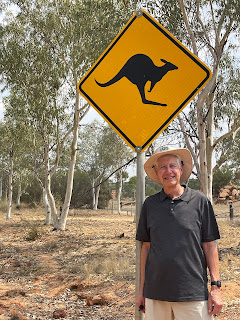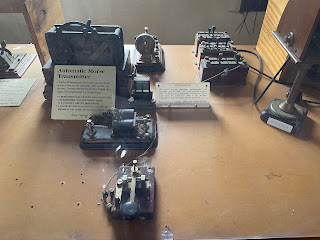This morning we took a van to the airport and flew from Melbourne to Alice Springs. We are almost exactly in the middle of the continent. This small city of a bit fewer than 30,000 residents is the only habitation for a couple hundred miles around. It is roughly halfway between Darwin, in the north, and Adelaide, in the south -- each almost 1,000 miles away.
It's hot here. The high temperature today was 99. It's dry scrubby land of reddish clay with absolutely no agricultural value.
This "Red Centre" of Australia was still largely unexplored territory in the mid-18th century. Explorers who attempted expeditions here either died of thirst and were never heard from again, or turned back without getting too far inland. Only one expedition, led by a Scot named John Stuart, made the trek from south to north in 1862.
In 1870 the Australian Post Office appropriated money to build a telegraph line across the country following Stuart's route. At Darwin (which also was not yet a city at the time), an undersea cable would continue to Asia and connect Australia to the world. Information from Britain, that required 3-4 months to arrive by sea, would now arrive in a matter or hours.
Building the telegraph was a huge feat of engineering. Camels were imported and used for construction because horses could not survive the desert. The technology as it existed at the time required relay stations roughly every 200 miles. Surveyor W.W. Mills selected this site for one of those relay stations -- the midpoint of the telegraph -- and named it after the wife of his boss, Australian Postmaster Sir Charles Todd. Alice never actually came here.
Unfortunately, Mills was mistaken in his naming, not because of Alice, but because he happened to arrive here after a rather uncharacteristic series of rains. In fact, there are no springs at Alice Springs. There is almost no water at all, just a dry riverbed.
Nevertheless, the station was built and the line was completed in 1872. A stationmaster and family, along with a small crew of telegraph operators and linemen, took up residence. Initially, supplies only arrived once a year by camel caravan!
Eventually, a small settlement grew up near the telegraph station. The discovery of gold about 60 miles to the east in 1887 brought an influx of Europeans. Eventually, a railroad was built along the telegraph route, but Alice Springs did not see rail connection until 1929.
After lunch and a visit to the telegraph station and museum, we made a brief stop on "ANZAC Hill," a war memorial. Some 200,000 military personnel passed through Alice Springs during WW II. Then we checked into a DoubleTree Inn that is at least a half hour walk from anywhere. We sat by the pool awhile, snacked in the bar, and ended our day.








No comments:
Post a Comment